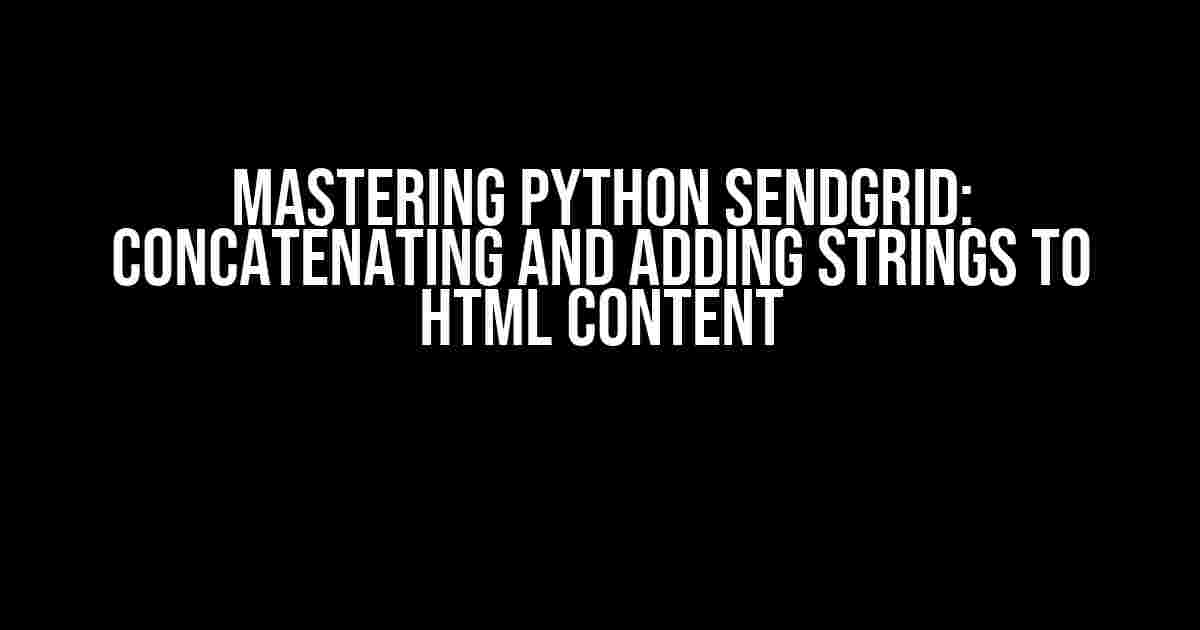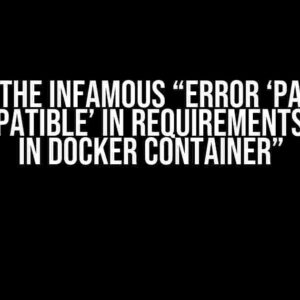Welcome to the world of Python Sendgrid, where sending emails has never been easier! In this article, we’ll dive into the process of concatenating and adding strings to HTML content using Python Sendgrid. Get ready to learn the ins and outs of this powerful email service provider and take your email game to the next level!
What is Python Sendgrid?
Python Sendgrid is a cloud-based email service provider that allows you to send emails programmatically using Python. With its robust API and extensive features, Sendgrid has become a popular choice among developers and businesses alike. Whether you’re building a web application, sending newsletters, or automating transactional emails, Python Sendgrid has got you covered.
Why Concatenate and Add Strings to HTML Content?
When sending emails using Python Sendgrid, it’s not uncommon to need to customize the content based on user input, database values, or other dynamic data. That’s where concatenating and adding strings to HTML content comes in. By dynamically generating HTML content, you can create personalized and engaging emails that resonate with your audience.
Scenarios Where Concatenation and String Addition are Essential
- Personalized email greetings based on user names or titles
- Dynamically generated content based on user preferences or settings
- Transactional emails with customized information (e.g., order confirmations, password resets)
- Automation of repetitive tasks, such as sending bulk emails or newsletters
Concatenating and Adding Strings to HTML Content in Python Sendgrid
To get started, you’ll need to have Python installed on your machine, along with the Sendgrid library. If you haven’t already, install Sendgrid using pip:
pip install sendgridPreparing Your HTML Content
Create a basic HTML template using a string or a template engine like Jinja2. For this example, we’ll use a simple string-based approach:
html_content = """
<html>
<body>
<p>Hello, {}!</p>
</body>
</html>
"""Concatenating Strings using the `format()` Method
In this example, we’ll use the `format()` method to replace the `{}` placeholder with a dynamic value:
name = "John Doe"
html_content = html_content.format(name)
print(html_content)The output will be:
<html>
<body>
<p>Hello, John Doe!</p>
</body>
</html>Adding Strings using the `+` Operator
Alternatively, you can use the `+` operator to concatenate strings:
html_content = html_content + "<p>This is an additional paragraph.</p>"
print(html_content)The output will be:
<html>
<body>
<p>Hello, John Doe!</p>
<p>This is an additional paragraph.</p>
</body>
</html>Sending Emails with Python Sendgrid
Now that we’ve prepared our HTML content, let’s send it using Python Sendgrid:
import os
from sendgrid import SendGridAPIClient
from sendgrid.helpers.mail import Mail
sg_client = SendGridAPIClient(os.environ.get("SENDGRID_API_KEY"))
mail = Mail(
from_email="[email protected]",
to_emails="[email protected]",
subject="Hello from Python Sendgrid!",
html_content=html_content
)
response = sg_client.mail.send.post(request_body=mail.get())
print(response.status_code)In this example, we’re using the Sendgrid API client to create a mail object, which is then sent using the `mail.send.post()` method. Make sure to replace `[email protected]` and `[email protected]` with your actual email addresses.
Best Practices and Tips
When working with Python Sendgrid and concatenating strings to HTML content, keep the following best practices in mind:
- Use a template engine like Jinja2 to separates concerns and maintain flexibility.
- Avoid concatenating user-input data directly into your HTML content to prevent XSS vulnerabilities.
- Use Unicode characters and HTML entities to ensure proper encoding and display.
- Test your emails thoroughly to catch formatting issues and broken links.
Conclusion
By mastering the art of concatenating and adding strings to HTML content, you can unlock the full potential of Python Sendgrid and create engaging, personalized emails that resonate with your audience. Remember to follow best practices, test thoroughly, and keep your HTML content clean and maintainable.
So, what are you waiting for? Dive into the world of Python Sendgrid and take your email game to the next level!
| Keyword | Description |
|---|---|
| Python Sendgrid | A cloud-based email service provider for sending emails programmatically using Python. |
| Concatenation | The process of joining two or more strings together to form a new string. |
| String addition | The process of combining two or more strings using the `+` operator. |
| HTML content | The content of an HTML document, including text, images, and other elements. |
Happy coding, and don’t forget to optimize your email campaigns for better delivery and engagement!
Frequently Asked Question
Get ready to unlock the secrets of Python Sendgrid and master the art of concatenating strings to HTML content!
Q1: How do I concatenate a string to HTML content in Python Sendgrid?
Easy peasy! You can use the ‘+’ operator to concatenate a string to HTML content. For example: `html_content = ‘
Hello
‘ + ‘
World!
‘`. This will result in a single HTML string that combines both parts.
Q2: What if I want to concatenate multiple strings to HTML content in Python Sendgrid?
No problem! You can use the `join()` method to concatenate multiple strings to HTML content. For example: `html_content = ”.join([‘
Hello
‘, ‘
World!
‘, ‘
Python Sendgrid rocks!
‘])`. This will result in a single HTML string that combines all the parts.
Q3: Can I use a template engine like Jinja2 to concatenate strings to HTML content in Python Sendgrid?
Absolutely! Jinja2 is a popular template engine that allows you to concatenate strings to HTML content using variables and templates. For example: `template = Environment().from_string(‘
Hello {{ name }}!
‘); html_content = template.render(name=’World’)`. This will result in a rendered HTML string that replaces the variable with the actual value.
Q4: How do I ensure that my concatenated HTML content is properly encoded in Python Sendgrid?
Great question! To ensure that your concatenated HTML content is properly encoded, you can use the `html.escape()` function from the `html` module. For example: `html_content = html.escape(‘
Hello World!
‘)`. This will escape any special characters in your HTML content.
Q5: Can I concatenate strings to HTML content in Python Sendgrid using the `format()` method?
Yes, you can! The `format()` method is another way to concatenate strings to HTML content. For example: `html_content = ‘
Hello {}!
‘.format(‘World’)`. This will result in a formatted HTML string that replaces the placeholder with the actual value.


